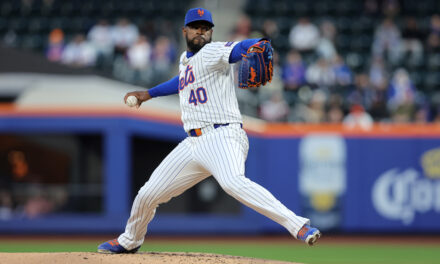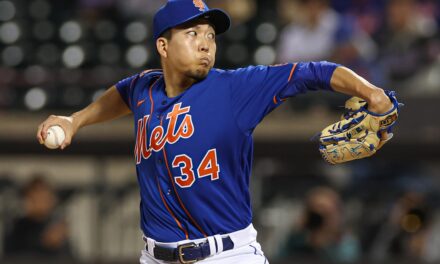
Steven Matz’ season debut quickly went south, giving up seven earned runs in the second inning in route to a 10-3 New York Mets loss against the Miami Marlins. Matz exhibited one mechanic flaw leading to his lack of command, particularly in two-strike counts, resulting in the Marlins second inning carousel around the bases.
Steven Matz (L, 0-1) 1.2 IP, 7 R, 6 H, 1 SO, 2 BB
Arrows were pointing up after watching a one, two, three first inning with fastball velocity at 95 mph, culminating in striking out one of Major League Baseball’s best power hitters, Giancarlo Stanton.
Unfortunately, Matz started the second inning breaking one of the cardinal rules of pitching, walking leadoff man Martin Prado. When a leadoff hitter makes it to first base, he scores approximately 35% of the time. Making matters worse, Matz walked the following batter Chris Johnson. Five of the next seven batters grinded out hits, including a Giancarlo Stanton man-bomb home run to left field, knocking Matz out of the game.
The frustrating aspect for Matz and Mets fans alike was during all three Marlins RBI single at-bats, Matz was ahead in the count 1-2 or 2-2. Matz proceeded throwing hanging curveball after hanging curveball. Even in Marcel Ozuna’s pop-out, both two strike pitches were hanging curveballs which thankfully Ozuna missed (Side note: Ozuna can’t hit an outside pitch….at all). Obviously, Matz objective was not to hang curveballs or throw hittable two-strike pitches. The reason lies in Matz release point.
Simply, Matz throwing arm lagged behind his body forcing his release point to be late, rushed and higher than normal as opposed to his normal release point out in front of his body. This results in an inability for Matz throwing fingers to stay on top of the baseball.
Matz, and every other Major League pitcher, needs his fingers on top of the baseball at release, allowing his fingers to stay on top of the seams on the baseball. This allows his fingers to manipulate the spin of the baseball at release, whether ripping down on the seams for a four-seam fastball or getting over the top of the baseball throwing a curveball.
Consequently, Matz fingers come around the seams of the baseball instead of over the seams of the baseball when throwing his curveball, resulting in a weak spin rate and a floating or hanging curveball. Additionally, fastballs tend to sail high and towards the throwing arm side (up and to the left for Matz) out of the strike zone as seen in four straight fastballs during Prado’s leadoff walk.
Why Matz arm lagged is a separate question I couldn’t unveil through the TV broadcast. Originally, Matz appeared throwing across his body, meaning his stride/planting leg lands too far left towards first base, blocking off his arm from releasing the baseball out in front of his body. But this was not the case as Matz was landing with good alignment towards home plate. Other reasons could include rushing his motion or opening his front shoulder and glove hand too soon but I didn’t see those either.
Whatever the reason, pitching on ten days rest is very difficult, especially for a starting pitcher in a rhythm and routine created during spring training. Do not put too much stress in the results of this start.
Stat of the Night
The New York Mets have the worst team batting average (.185) and OPS (On-base percentage plus slugging percentage, .529) in Major League Baseball thus far this season.
Follow Chris Zaccherio on Twitter @ziography for more Mets insight going beyond statistics.















